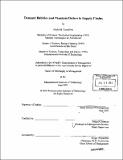Demand bubbles and phantom orders in supply chains
Author(s)
Gonçalves, Paulo Márcio, 1968-
DownloadFull printable version (13.41Mb)
Other Contributors
Sloan School of Management.
Advisor
John D. Sterman.
Terms of use
Metadata
Show full item recordAbstract
Essay One The Impact of Shortages on Push-Pull Production Systems This paper explores the impact of endogenous customer demand on supply chain instability. It investigates how a semiconductor manufacturer's hybrid push-pull production system responds to customer demand, when inventory availability influences demand. While customers' response to variable service level represents an important concern in industry with sizable impacts on company profitability, previous models exploring supply chain instability do not address it. This research incorporates customer response in two important ways. First, a negative feedback loop of lost sales captures the effect that an initial increase (decrease) in demand leads to a decrease (increase) in the manufacturer's service level, causing customer demand to decrease (increase). Second, a positive feedback loop of production push characterizes the manufacturer increase (decrease) in capacity utilization to respond to a surge (drop) in demand, leading to high (low) production volumes and service levels, and a further increase (decrease) in demand. The manufacturer's hybrid push-pull production system is very effective in meeting customer demand. Stockouts at different stages in the supply chain, however, can shift the operation mode of the system to a defacto push system. The shift to a push system decreases the manufacturers' service level and increases demand variability. The analysis suggests that the endogenous customer demand assumption influences the shifts in modes of operation through the lost sales and production push loops, leading to higher supply chain instability than when customer demand is modeled as exogenous. (cont.) In addition, incorporating the endogenous demand assumption leads to a different inventory and utilization policies than the ones currently adopted. First, this research finds that supply chains can operate in multiple modes, due to demand instability. It also provides policies capable of mitigating the impact from shifts in operation modes. Second, it suggests that models investigating instability in supply chains assuming exogenous demand may underestimate the amplification in demand and the value of inventory buffers. The model analyzed in this paper gives insights into the costs of lean inventory strategies in the context of hybrid production systems. Essay Two Why do Shortages Inflate to Huge Bubbles? When demand exceeds supply, customers often hedge against shortages by placing multiple orders with multiple suppliers. The resulting demand bubble creates instability leading to excess capacity, excess inventory, low capacity utilization, and financial and reputation losses for suppliers and customers. This paper contributes to the understanding of demand bubbles caused by shortages by providing a comprehensive causal map of supplier-customer relationships and a formal mathematical model of a subset of those relationships. It provides closed form solutions for supply chain dynamics when supplier capacity is fixed and simulation analysis when it is flexible. Sensitivity analysis provides a deeper understanding of structures and decision rules that contribute to bubbles and suggests policies for improvement. For instance, the ability to quickly build capacity can reduce bubble size ...
Description
Thesis (Ph. D.)--Massachusetts Institute of Technology, Sloan School of Management, 2003. Includes bibliographical references.
Date issued
2003Department
Sloan School of ManagementPublisher
Massachusetts Institute of Technology
Keywords
Sloan School of Management.